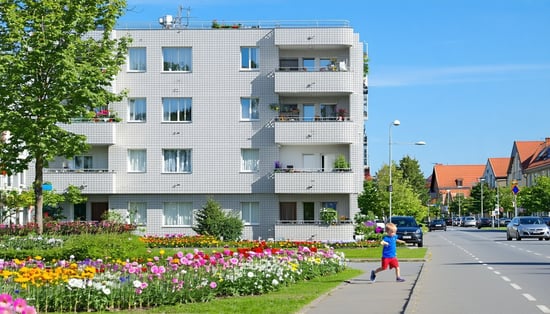One-room apartment investments are often marketed to salaried workers with promises like “you can start with little capital” and “it can serve as a future pension.” However, beginners should be cautious about jumping into this without proper research. In fact, the National Consumer Affairs Center receives over 1,000 to 2,000 consultations annually regarding investment apartments, with many citing issues such as “aggressive solicitation” and “insufficient explanations.” This article provides a detailed explanation of the mechanisms, potential risks, and past failures of one-room apartment investment. It is important to avoid overly optimistic expectations and instead develop a realistic understanding of the risks and strategies to mitigate them.
The Mechanism and Return Structure of One-Room Apartment Investment
● Basic Mechanism of Investment: One-room apartment investment involves purchasing a single unit (stake ownership) in an apartment building and renting it out to generate rental income. The purchase funds are sourced from personal savings or loans from financial institutions, and the remaining amount after deducting loan repayments, management fees, and maintenance costs from the rental income is the profit (cash flow) that remains in your hands. If managed smoothly, in the long term, the rental income can become a source of income in retirement after the loan is fully repaid, or the property can be sold to generate capital gains (sale proceeds). However, in reality, various costs such as monthly management fees, repair reserves, and property taxes are incurred, so a careful budget plan is necessary to achieve the expected profits.
● Structure and Level of Yield: In real estate investment, yield (annual income ÷ property price) is one key indicator. Advertisements often state “surface yield of X%,” but this figure does not account for expenses. The actual net yield, which reflects the actual take-home amount, decreases by the amount of management fees and taxes, and is generally about 1% lower than the surface yield. In recent years, the yield on one-bedroom apartments in urban areas has been declining, with the average surface yield for one-bedroom apartments in Tokyo currently around 4% (as of 2025), a significant drop from the days when experts once said that anything below 10% was “out of the question.” In new properties in central Tokyo, there are even cases where the surface yield is as low as 2–3%, and after deducting loan interest rates and various expenses, the monthly cash flow is likely to be negative. It is essential not to be swayed by yields alone and to prepare sufficient capital and conduct a solid cash flow calculation.
The pitfalls hidden in sweet sales pitches
Sales representatives often use seemingly attractive sales pitches to alleviate the concerns of beginners. However, these sweet sales pitches may contain misunderstandings or risks, so caution is necessary. Let's examine some common sales pitches and their pitfalls.
- “The prime location in the city center means low vacancy risk and peace of mind.” – While rental demand is relatively high in city centers, rental rates for one-bedroom apartments are highly likely to decline over time. If the property breaks even or operates at a loss at the time of purchase, future rent decreases will further worsen the financial situation. Especially for new one-bedroom units, the first year's rent often includes a “new construction premium” (markup), making it more likely for rent to drop significantly after the first tenant moves out. In fact, data shows that rent can drop by nearly 20% from its peak within 10 years of construction. Even if the location is good and there are few vacancies, it is important to understand that properties with too low a yield are fundamentally difficult to profit from.
- “Think of the monthly out-of-pocket expense of 10,000 to 20,000 yen as insurance for the future” – If you cannot cover loan repayments with rent and end up with a monthly deficit, this is a sign that rental management is not going well. If you ignore this because you can cover the deficit with your salary, it could lead to financial institutions refusing to grant additional loans when you want to purchase more properties. Additionally, while some may explain that “the loan comes with group credit life insurance, which can serve as life insurance,” by the time the loan is fully paid off, the property will be decades old, its asset value will have significantly decreased, and considering the losses incurred up to that point, it cannot be considered sufficient as insurance. Paying a fixed monthly premium to receive a guaranteed payout is a more reasonable approach.
- “Depreciation reduces taxes, so it's a net gain overall.” – One-room apartments are made of reinforced concrete (RC), so the depreciation period is 47 years, and the annual depreciation expense is minimal. Therefore, the tax savings are limited, and there are almost no benefits for those earning less than 900,000 yen annually. Paying a monthly loss just for a small tax refund is counterproductive, and the claim that “it saves taxes” is a sophisticated argument to justify operating at a loss.
As mentioned above, blindly believing sales pitches can lead to overlooking significant risks. It is important to calmly identify the underlying assumptions and numerical tricks behind the claims and verify the plan based on a pessimistic scenario rather than an optimistic one.
Key risks to consider when investing in one-room apartments
One-room apartment investments carry various inherent risks. Among these, we will explain the representative risks that beginners should particularly be aware of. If you have any concerns, consult with an expert and take appropriate measures before making an investment decision.
Vacancy risk (risk of zero income due to no tenants)
The biggest weakness of managing a single one-room apartment is that if it becomes vacant, rental income drops to zero. Since single-occupant properties have high tenant turnover, if a new tenant is not found after a tenant moves out, income will cease during that period. However, loans and management fees must be paid every month, so during the vacancy period, all expenses must be covered out of pocket. (During vacancies, loan repayments and expenses must be covered out of pocket)
Since a single one-room unit cannot diversify vacancy risk, this must always be kept in mind. For example, in a multi-unit apartment building, even if several units are vacant, the risk is spread out as rent from other units can cover the losses. When investing in one-room units, it is important to set aside contingency funds assuming that vacancies will occur for a certain period and to maintain the property's appeal to secure tenants as soon as possible.
Rent Decline Risk and Revenue Deterioration
Real estate rents fluctuate depending on the age of the property and market conditions. In particular, newly constructed properties tend to have higher initial rents, and there is a high risk of rent declines over time. In fact, looking at the rent index for one-room apartments in central Tokyo, rents have decreased by approximately 20% after 10 years and continue to decline gradually thereafter (a trend of approximately a 20% decrease in rent from 0 to 25 years).
If rents decline, monthly cash flow will be squeezed, and since the value of investment properties is linked to rental income, this will directly impact asset value. Even in cases where rent is guaranteed through a sublease agreement, there are instances where the guaranteed rent is reduced at the time of contract renewal (as discussed later). If you do not incorporate a buffer into your cash flow plan to account for future rent declines, there is a risk of falling into the red sooner than anticipated.
Increased burden from maintenance reserves and operating expenses
In apartment building management, maintenance and management costs for the building itself cannot be overlooked. Even if maintenance costs are low initially due to the building's age, maintenance reserves and management fees may increase over time. In newly constructed apartments, management fees and reserves are often set low at the time of sale and increased after a few years. Additionally, as the building ages, major repairs such as elevators or exterior walls may become necessary, leading to the collection of additional reserve funds (so-called “one-time payments”).
Furthermore, when tenants move out, restoration costs (such as house cleaning or interior repairs) are incurred. Over the long term, equipment replacement may also be necessary. If rental income cannot keep pace with these increasing costs, a property that was initially profitable may gradually turn into a loss-making property with increasing out-of-pocket expenses. Particularly, it has been pointed out that by the time a property is over 35 years old, sudden repairs may increase, and there is a possibility that major repair costs cannot be covered by rental income alone. It is essential to incorporate the risk of future maintenance cost increases into long-term cash flow simulations.
Asset value depreciation and sale risk
Real estate prices fluctuate depending on market conditions after purchase. In the case of one-room condominiums, it is important to note that the “new construction premium” may quickly diminish after purchase, leading to a significant decline in resale value. Various purchase-related expenses (such as brokerage fees and registration costs) typically amount to around 10% of the purchase price, but these are not reflected in the asset value and are often unrecoverable at the time of sale. If the economy or real estate market deteriorates, property prices may decline, leading to the risk of falling into an “over-mortgage” situation where the property cannot be sold for more than the remaining loan balance.
Especially for older properties, while they may be attractive for their yield, they may be difficult to sell in the market due to low liquidity. Properties without tenants become even harder to sell. A decline in rent directly affects the property value estimated using the income capitalization method, so failing to make efforts to maintain or increase rent during the investment period may result in losses even when selling the property. It is important to recognize that even with long-term holding, achieving capital gains upon sale is not easy, and overly optimistic assumptions should be avoided.
Other risks (loan interest rates, delinquencies, disasters, etc.)
In addition to the above, there is the general real estate investment risk of interest rate fluctuations. If you are using a variable-rate loan in the current low-interest-rate environment, an increase in interest rates in the future could lead to higher repayment amounts and worsen cash flow. Additionally, risks such as rent delinquency by tenants and disaster risks (e.g., fire or earthquake) must be considered. While fire insurance and earthquake insurance can cover some of the risks, indirect damages such as vacant periods that cannot be compensated by insurance should also be anticipated. In summary, real estate investment involves multifaceted risks, so it is important to understand why it is referred to as a “medium-risk, medium-return investment” before proceeding.
The pitfalls of new and used one-room apartments
While one-room apartment investment may sound similar, there are differences in the advantages and disadvantages between new and used properties. It is important to understand the issues associated with each.
● Newly built one-room apartments: Newly built properties feature the latest facilities and earthquake resistance, and initial maintenance costs are low. However, this comes at the cost of a higher property price due to the “newly built premium,” resulting in a lower surface yield. As mentioned earlier, rent tends to decline immediately after occupancy begins, and the property value may drop by several hundred thousand dollars when sold as a used property shortly after purchase. Additionally, at the time of construction, building maintenance reserves are often set at lower levels, with some cases seeing these reserves double after 10 years. “New construction does not guarantee safety”, and the perceived safety comes at the cost of higher property prices and lower yields.
● Used one-room apartments: Used properties offer the advantage of lower prices and relatively high surface yields (3–4.5% for used one-room apartments in the Tokyo metropolitan area built within the last 20 years). Compared to new construction, the risk of value depreciation immediately after purchase is smaller, and if purchased at a reasonable price, it is easier to achieve a balanced investment with rent. On the other hand, as the building ages, maintenance costs and vacancy risks increase. Older properties are often avoided due to their appearance and facilities, leading to lower rents. As the building ages, the loan period from financial institutions tends to shorten. Additionally, extremely old properties may require consideration of future redevelopment issues (such as reaching agreements among co-owners). When investing in used properties, it is crucial not to be swayed by surface-level yields alone. Instead, thoroughly check the building's management status, maintenance history, and surrounding market prices to purchase at a reasonable price.
The Importance of Location Selection and Supply-Demand Balance
In real estate investment, the location of a property is often said to account for 90% of its success. Properties in areas with low demand, poor safety, or distant from stations have been reported to suffer from prolonged vacancies and inability to generate rental income. In some cases, investors who purchased properties in poor locations ended up having to cover all loan repayments out of their own pockets due to the lack of tenants. If vacancies persist, landlords may be forced to lower rents to attract tenants, and rental rate declines directly impact the property's asset value.
On the other hand, even prime locations in urban areas are not without risks. In Tokyo's central business district, population growth has slowed, and changes in demand for single-occupant units are beginning to emerge, making future supply-demand balance uncertain. Furthermore, urban areas have many competing rental properties, and if new condominiums are built in the surrounding area, the appeal of your property may diminish relatively. It is important to assess the location from a long-term perspective, considering factors such as whether the area has stable demand, future demographic trends, and development plans. Before purchasing a property, it is essential to thoroughly research the rental market in the area (vacancy rates and rental levels of competing properties) by consulting a real estate company or visiting the location yourself during weekdays, evenings, and weekends to check the living environment.
Potential issues with sublease contracts
Sublease contracts (where the property is leased in bulk with guaranteed rent) are often recommended by agents as a way to avoid vacancy risks, but their actual terms require careful attention. In a sublease agreement, the management company leases the property in bulk and pays the owner a guaranteed rent. While this may seem advantageous at first glance, most contracts include clauses allowing for adjustments to the guaranteed rent. For example, while the contract may state “30-year rent guarantee,” the fine print may specify that the guaranteed amount can be reduced every few years. The National Consumer Affairs Center has reported cases where tenants were told that rent income would be guaranteed, only to later discover that the guarantee had an expiration date, resulting in a deficit in their income.
Even more concerning is the risk that the sublease company itself may go bankrupt. In 2018, a company famous for shared housing investments went bankrupt, leaving property owners whose rent guarantees were cut off unable to repay their loans and forced into bankruptcy. When entering into a sublease contract, it is essential to carefully review the terms and conditions regarding rent reductions or termination in the contract. If any terms are unclear, it is important to have the courage to refrain from signing the contract. Additionally, rather than relying solely on subleasing, selecting a property that can be managed independently is the fundamental approach to mitigating risks.
Learning from actual failure cases
The risks mentioned above are not merely theoretical; they are real challenges faced by many beginners. According to a report by the Consumer Affairs Agency, the number of consultations regarding investment apartments from individuals in their 20s increased from 160 cases in the 2013 fiscal year to 405 cases in the 2018 fiscal year, a 2.5-fold increase. Among these cases, there are instances of aggressive sales tactics, such as being summoned to a restaurant by a salesperson and not being allowed to leave until signing a high-priced contract, as well as cases where individuals were told that future rent would be guaranteed but found themselves unable to repay their loans after the guarantee period expired. As such, those with limited knowledge and negotiation skills are more likely to become targets and find themselves in irreversible situations.
Additionally, valuable lessons can be learned from the experiences of investors who have actually purchased properties. For example, H, a high-income company employee earning over 20 million yen annually, was told by a salesperson that “taxes would be refunded through depreciation, allowing losses to be offset,” and purchased several newly constructed one-bedroom units in a prime location. However, while there was a tax refund in the first year, it drastically decreased in subsequent years, resulting in a monthly deficit of tens of thousands of yen that had to be covered out of pocket. H regretted taking the sales pitch at face value and eventually sold the properties and revised their investment strategy. Other cases include someone who kept adding one-bedroom units because they were affordable, only to end up with a ballooning total debt and no room to maneuver, and someone who became anxious about potential losses from vacancies and repairs and decided to change their investment strategy. What these failure stories have in common is that the initial assumptions were too optimistic and the sales pitch was not questioned. Let's learn from the mistakes of others and avoid repeating the same mistakes.
Key points and alternative strategies highlighted by experts
Real estate investment experts and experienced investors have sounded the alarm about the risks of one-room apartment investments while also proposing several countermeasures and alternative strategies.
- Consider investing in a single-building property for risk diversification: If your funds and borrowing capacity allow, considering an investment in a single-building apartment or condominium from the start is one option. While the purchase price will be higher, you can diversify vacancy risks by generating rental income from multiple units, making it easier to achieve stable returns compared to one-room apartments. While management efforts increase, this approach is seen as a form of risk hedging.
- Securing Yields with Regional Properties or Used Units: Since new one-bedroom units in urban areas offer extremely low yields, another strategy is to target properties in regional cities or used condominium units for higher yields. For example, in areas near stations in major regional cities with anticipated demand, properties can be purchased at lower prices than in Tokyo, with surface yields of 5–8%. However, rural areas also carry the risk of population decline, so it is essential to carefully assess demand trends and select properties with caution. Additionally, while used condominiums offer a better balance between price and rent as mentioned earlier, it is important to avoid overly old properties and select those in good condition.
- Detailed investment planning and consultation with experts: Regardless of the strategy chosen, it is essential to conduct a detailed simulation of income and expense projections under pessimistic scenarios. Verify whether you can withstand stress scenarios such as a vacancy rate of X%, a rent decline rate of X%, and an interest rate increase of X%, and ensure you have sufficient equity. If you find it difficult to make decisions on your own, consulting with a real estate investment expert in a neutral position can be effective. Hearing opinions from a third party other than sales representatives can help reduce oversights and biases.
- Start small and gain experience: If you are new to real estate investment, it is a good idea to start small without taking on too much risk. For example, even with a one-room investment, you can keep your loan amount low and put down a larger down payment, or purchase a relatively inexpensive used one-room apartment with cash. By trying it out while keeping some cash on hand, you can gain experience and knowledge without suffering a fatal blow even if the income and expenses do not turn out as expected. It is safer to take the next step after gaining experience and knowledge.
In conclusion
While one-bedroom apartment investments are easy to start, they also come with numerous risks that may not be immediately apparent to beginners. Avoid being swayed by promises like “passive income from rent,” and instead focus on the realistic risks mentioned here, such as vacancies, rent declines, increased maintenance costs, and depreciation of asset value. If your plan holds up after a thorough, pessimistic analysis, you can aim for long-term asset growth while minimizing risks. Real estate investment is positioned as a steady investment with moderate risk and moderate returns. The first step toward success is to make wise decisions based on an understanding of the realities that cannot be dismissed with a simple “I didn't know.” Even if you are a beginner, please use this article as a reference to conduct thorough risk management and strive for safe and secure real estate investment.




